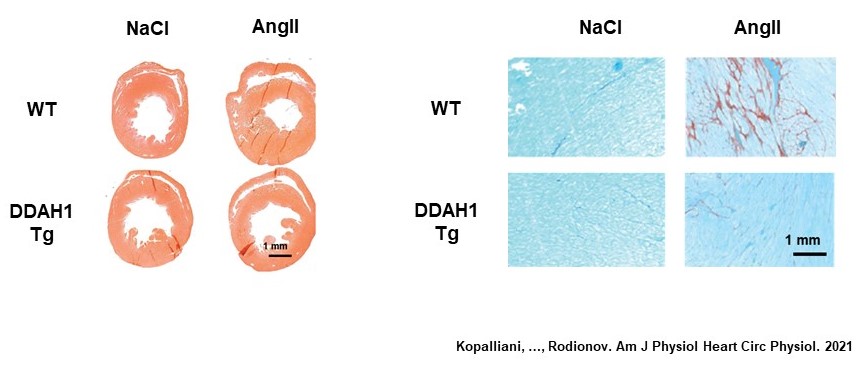Current research projects
1. Role of the non-classic cardiovascular risk factor asymmetric dimethylarginine (ADMA) in aortic and myocardial remodeling
Asymmetric dimethylarginine (ADMA) is an endogenous methylated analogue of L-arginine, which is produced during turnover of the proteins that are methylated on arginine residues (e.g. histones). ADMA competes with L-arginine for the active site of nitric oxide (NO) synthases and inhibits NO production. Additionally, ADMA "uncouples" NO synthases, which means that they start producing a highly reactive free radical superoxide instead of NO. Multiple epidemiological studies have identified ADMA as an independent predictor of cardiovascular complications and mortality in general population and in patients with cardiovascular diseases. Animal and cell culture studies as well as a short-term infusion of ADMA in healthy human volunteers have shown that ADMA can directly cause vascular damage. The major pathway for catabolism of ADMA is to citrulline via the enzyme dimethylarginine dimethylaminohydrolase 1 (DDAH1), which is abundantly expressed in multiple tissues including heart and vessels. ADMA can also be metabolized through an alternative pathway by alanine:glyoxylate aminotransferase 2 (AGXT2), while this second pathway is specific for liver and kidneys.

Our group is using complementary cell culture and in vivo approaches to determine the role of ADMA/DDAH1/AGXT2 system in cardiovascular system. An example of our experimental cardiovascular study is demonstration that overexpression of DDAH1 in mice with subsequent lowering of ADMA concentration in tissue and blood protects from angiotensin-II-induced adverse aortic and cardiovascular remodeling. Wild type mice (WT) demonstrate an increase in aortic wall thickness as well as excessive collagen deposition (orange) after infusion of angiotensin II (AngII) for 4 weeks in comparison with mice, which received infusion of saline (NaCl). In contrast, the same does and duration of of angiotensin II infusion did not lead to aortic wall hypertrophy and excessive collagen deposition in DDAH1 transgenic mice (DDAH1 Tg).

DDAH1 overexpression and ADMA lowering also protected against myocardial hypertrophy and excessive collagen deposition in myocardium.

2. Regulation of mitochondrial injury in cardiovascular diseases
Mitochondrial fusion is the process of two mitochondria joining together, while mitochondrial fission is the process of mitochondrial division. Impaired equilibrium between mitochondrial fission and fusion has been recently recognized as a critical marker and contributor to cardiovascular damage. We are currently investigating the role of the recently discovered regulators of mitochondrial fission in experimental models of cardiovascular injury.
3. Role of ADMA/DDAH1/AGXT2 pathway outside of cardiovascular system
We collaborate with other groups on the projects involving the role of ADMA/DDAH1/AGXT2 pathway outside of the cardiovascular system. Some diseases and pathological processes, in which this pathway may play an important role, include renal diseases, metabolic diseases, cirrhosis, sepsis, cancer, neurodegenerative diseases and pulmonary diseases.
4. Role of homoarginine in pathogenesis of cardiovascular, renal and metabolic diseases
Homoarginine is an endogenous nonproteinogenic amino acid, which has been proposed to play a protective role in stroke, heart failure, metabolic syndrome and renal diseases. The exact mechanisms of the proposed protective effects of homoarginine are not entirely understood and are among the research interests of our group.

